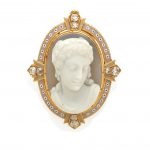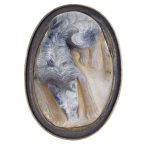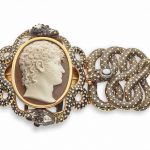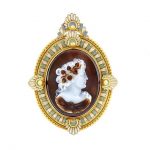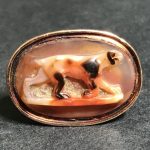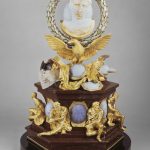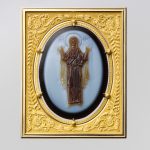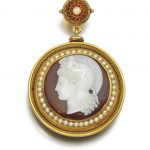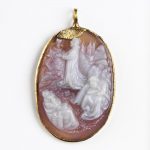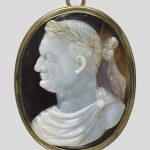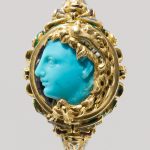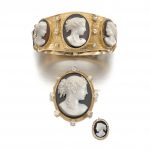Information on agate including it’s use in cameo carving. Agate is one of the most common materials used in the art of hardstone carving, and has been recovered at a number of ancient sites, indicating its widespread use in the ancient world, for example, archaeological recovery at the Knossos site on Crete illustrates its role in Bronze Age Minoan culture.
An enamel, diamond, carved agate and gold cameo brooch gross weight approximately: 26 grams; length: 1 7/8in.
Sold for US$ 1,375 (£ 1,045) inc. premium at Bonhams in 2017
Agate cameo engraved with a long-haired dog lying down.
Reference: © The Trustees of the British Museum
BRACELET, AGATES, CITRINES, RUBIES AND DIAMONDS circa 1830 Adorned with an oval-shaped agate cameo representing Joachim Murat, the rim of the cameo and the links of the bracelet (sectioned hinges) adorned with intertwined serpents with black and white enamelled decoration, punctuated with agates, citrines and diamonds, the eyes set with ruby, yellow gold setting Detachable central part, possibly to wear as a belt buckle
Sold for EUR 7,500 at Christies in 2017
Antique Gold, Hardstone Cameo and Enamel Pendant-Brooch Centering one oval brown and white agate cameo depicting the profile of a lady, approximately 33.0 x 26.0 mm., surrounded by green and white enamel plaques, quartered by shell plaques, edged by twisted gold wire and beading, circa 1880, minor enamel loss, approximately 13.2 dwts.
Cameo: nice carving, translucent, good luster. Minor enamel loss and pitting. Several minor dings on reverse of gold frame. 2 5/16 x 1 3/4 inches.
Sold for $2,500 (includes buyer’s premium) at Doyle New York in 2018
Roman agate cameo ring of a dog, set in modern 14k gold mounting. Size 4, 4.5 dwts. Circa 2nd century AD.A wonderful example of Greek and Roman hardstone cameo carving.The dog is a pointer or bloodhound type, with the dark spots in the matrix of the stone being used as the dark spots on the dog’s ear and fur.
Sold for $800 at David Killen Gallery in 2018
In 1785, Luigi Valadier created a spectacular mounting for this no less exceptional cameo, carved in the 1st century AD with the likeness of the Roman emperor Augustus. Designed as a portable item of imperial propaganda, the bust is one of numerous portraits executed during Augustus’s reign (27 BC-AD 14), in pietre dure, marble, or in cameo form. The 18th-century mounting incorporates a number of antique elements: the eagle’s head, phalerae, and breastplate. A portrait of the emperor Augustus The cameo features an agate portrait bust of the emperor Augustus, dressed in the paludamentum or purple cloak of the commander-in-chief of the Roman army. Stylistically, the bust belongs to one of the principal types of carved portrait of Augustus (datable to c. 20 BC); it was probably carved during his lifetime at the beginning of the 1st century AD, and closely resembles a statue discovered at Livia’s villa in Prima Porta. The modeling of the emperor’s face conveys the same sense of energy; both works also include a similar hair arrangement, notably the distinctive part and cleft in the bangs over the left eye and temple.
Reference:The Louvre
Agate cameo of the Virgin and Child
This delicately carved cameo shows the Virgin in an orant pose, with her arms upraised, and a medallion of the Christ Child over her chest. This icon type is often called the Blachernitissa after a famous icon at the Blachernai Monastery in Constantinople.
Reference: The Metropolitan Museum of Art
Agate cameo pendant brooch, Luigi Rosi, 1870s Set with a circular agate cameo depicting Minerva, within a seed pearl and open work border in the Etruscan revival style, suspended from a fine rope work and seed pearl floral motif, detachable pendant fitting, signed L. Rosi, Roman assay mark.
Sold for 3,250 GBP at Sothebys in 2018
Vertical oval cameo. Milky white and dull, mottled, translucent pink layered agate. Depicting the Agony in the Garden. Christ kneels with clasped hands at the top facing left among rocks, a chalice in front of him. Below him the three apostles are shown sleeping, two on the right and one on the left. In the distance a group of buildings represents Jerusalem. Set in a simple gold mount with loop for suspension. Circa 1500
Reference: © Victoria and Albert Museum
“Antique” Cameo with Portrait of the Roman Emperor Vespasian
The Roman emperors were popular subjects for cameos (small relief carvings) in antiquity, and this cameo of Vespasian (AD 9-79) imitates that tradition. Cameos of the 16th and 17th centuries imitating Roman carving were often offered to collectors as Roman artifacts. Onyx was favored for cameos because its narrow veins of brown and white color can be carved to set off a white form against a brown background.
Reference: The Walter Art Museum
[geolocator_show for=”GB”][ebayfeedsforwordpress feed=”http://rest.ebay.com/epn/v1/find/item.rss?keyword=hardstone+cameo&sortOrder=BestMatch&programid=15&campaignid=5338252468&toolid=10039&customid=antique-cameos-rss-uk-hardstone-info&listingType1=All&feedType=rss&lgeo=1″ items=”20″][/geolocator_show]
[geolocator_hide for=”GB”][ebayfeedsforwordpress feed=”http://rest.ebay.com/epn/v1/find/item.rss?keyword=hardstone+cameo&sortOrder=BestMatch&programid=1&campaignid=5338252469&toolid=10039&customid=antique-cameos-rss-us-hardstone-info&listingType1=All&feedType=rss&lgeo=1″ items=”20″][/geolocator_hide]
